
Ansbach is a city in the German state of Bavaria. It is the capital of the administrative region of Middle Franconia. Ansbach is 40 kilometers southwest of Nuremberg and 140 kilometers north of Munich, on the river Fränkische Rezat, a tributary of the river Main. In 2020, its population was 41,681.
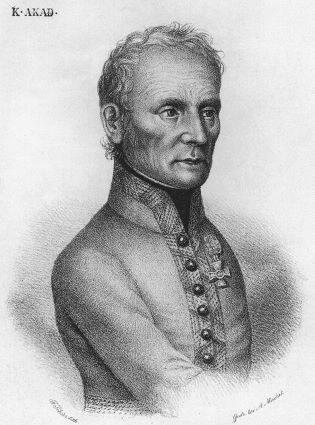
Karl Freiherr Mack von Leiberich was an Austrian soldier. He is best remembered as the commander of the Austrian forces that capitulated to Napoleon's Grande Armée in the Battle of Ulm in 1805.
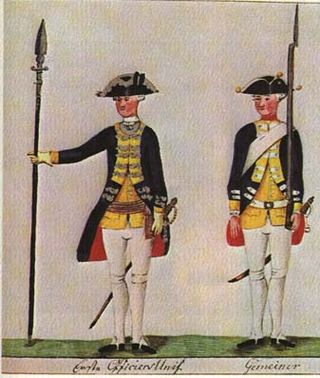
Hessians were German soldiers who served as auxiliaries to the British Army during the American Revolutionary War. The term is an American synecdoche for all Germans who fought on the British side, since 65% came from the German states of Hesse-Kassel and Hesse-Hanau. Known for their discipline and martial prowess, around 30,000 Germans fought for the British during the war, around 25% of British land forces.

The Battle of Kulm was fought near the town Kulm and the village Přestanov in northern Bohemia. It was fought on 29–30 August 1813, during the War of the Sixth Coalition. A French Corps under General Dominique Vandamme attacked Alexander Ostermann-Tolstoy's Russian Corps on 29 August. The next day, Friedrich von Kleist's Prussian Corps hit Vandamme in the rear while Russian and Austrian reinforcements attacked the French front and left. Vandamme was defeated with the loss of 13,000 men and 82 guns.
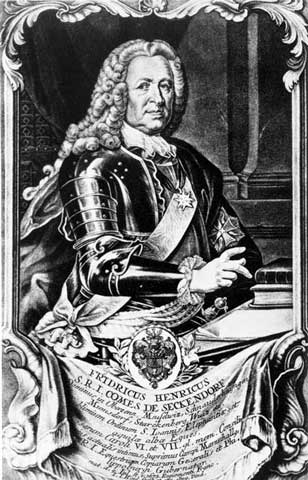
Friedrich Heinrich Reichsgraf von Seckendorff was a Franconian field marshal and diplomat, in the service of the imperial Habsburg monarchy of Austria. Later he served as commander of the Bavarian army and fought Austria.
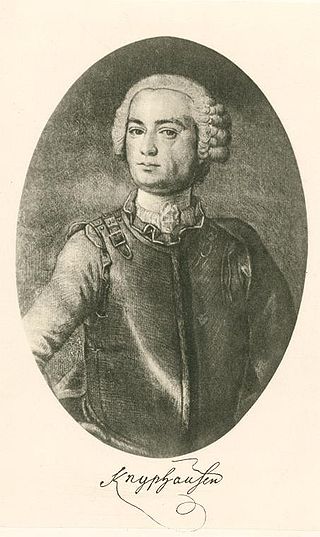
Wilhelm Reichsfreiherr von Innhausen und Knyphausen was a German general officer who served in Hesse-Kassel. He fought in the American Revolutionary War, during which he commanded Hessian auxiliaries on behalf of Great Britain.

The siege of Yorktown was the culminating act of the Yorktown campaign, a series of military operations occupying much of 1781 during the American Revolutionary War. The siege was a decisive Franco-American victory: after the surrender of British Lt. Gen. Charles, Earl Cornwallis on October 17, the government of Lord North fell, and its replacement entered into peace negotiations that resulted in British recognition of American independence with the 1783 Treaty of Paris.

Christian Friedrich Carl Alexander was the last margrave of the two Franconian principalities, Bayreuth and Ansbach, which he sold to the King of Prussia, a fellow member of the House of Hohenzollern.
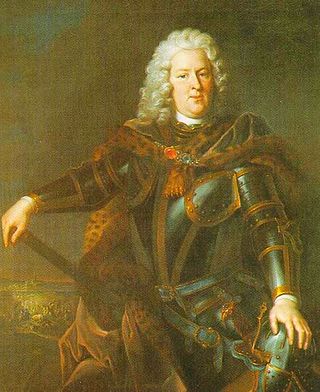
Frederick Louis of Württemberg-Winnental was a German army commander of the eighteenth century.

Ernst Heinrich August de la Motte Fouqué was a Prussian Lieutenant general and General der Infanterie and a confidant of King Frederick the Great. Fouqué held the title of Freiherr (baron).
The northern theater of the American Revolutionary War also known as the Northern Department of the Continental Army was a theater of operations during the American Revolutionary War.
"Der Hohenfriedberger", also called "Hohenfriedberger Marsch" or "Der Hohenfriedberger Marsch", is one of the most classic and well known German military marches. It takes its name from the victory of the Prussians over the allied Austrians and Saxons on 4 June 1745 during the Second Silesian War at the Battle of Hohenfriedberg, near Striegau.

Ethnic Germans served on both sides of the American Revolutionary War. Large numbers of Germans had emigrated to Pennsylvania, New York, and other American colonies, and they were generally neutral or supported the Patriot cause. Some belonged to pacifist sects such as the Amish, but many were drawn into the Revolution and the war.

Karl Gustav von Baggehufwudt was a lieutenant general of the Russian Empire who took part both in Napoleonic Wars and Finnish War. His family was originally Norwegian, but had moved to Sweden in the 16th century, then to Estonia in the 17th century.

The Battle of Ölper is a battle that took place on 1 August 1809 in Ölper, currently a district of the town of Brunswick, as part of the War of the Fifth Coalition. It pitched troops of the Kingdom of Westphalia against the Black Brunswickers under Frederick William, Duke of Brunswick-Wolfenbüttel, but ended in a tactical draw.
Friederich Ludwig Albrecht von Eyb was a military commander of Ansbach-Bayreuth. In 1776, when the American Revolutionary War broke out, the Kingdom of Great Britain appealed to various German princes for troops in return for payment. Von Eyb commanded the Bayreuth regiment from 1776 to May 1778, when he returned to Uffenheim.

Dubislav Friedrich von Platen was a Prussian officer in Frederick the Great's army. A cavalry general, he was also Governor of Königsberg, a Knight of the Order of Saint John, and a recipient of the Order of the Black Eagle. An active cavalry officer in all of the wars fought by Frederick—the War of Austrian Succession, the Second Silesian War, the Seven Years' War and, finally, the War of Bavarian Succession — he was commemorated on Equestrian statue of Frederick the Great in 1851 erected by Frederick's great-great nephew, Frederick William IV.

Friedrich Wilhelm von Lossberg was a Hessian Lieutenant General fighting with the British-allied German contingents in the American Revolutionary War. He was sent to America in 1776 as a colonel commanding the First Brigade of the Second Hessian Division under Lieutenant General Wilhelm von Knyphausen. Von Knyphausen in turn was second in command under General Leopold Philip de Heister.















